Key takeaways:
- Children’s creativity thrives on exploration and freedom, encouraging them to redefine ordinary concepts and embrace unfiltered expression.
- Nurturing creativity fosters essential skills like problem-solving, resilience, and emotional intelligence through hands-on activities and imaginative play.
- Creating a stimulating environment with accessible materials and encouraging open-ended play enhances children’s creative instincts and thinking.
- Involving children in decision-making boosts their self-esteem and creativity, making them feel valued and invested in outcomes.
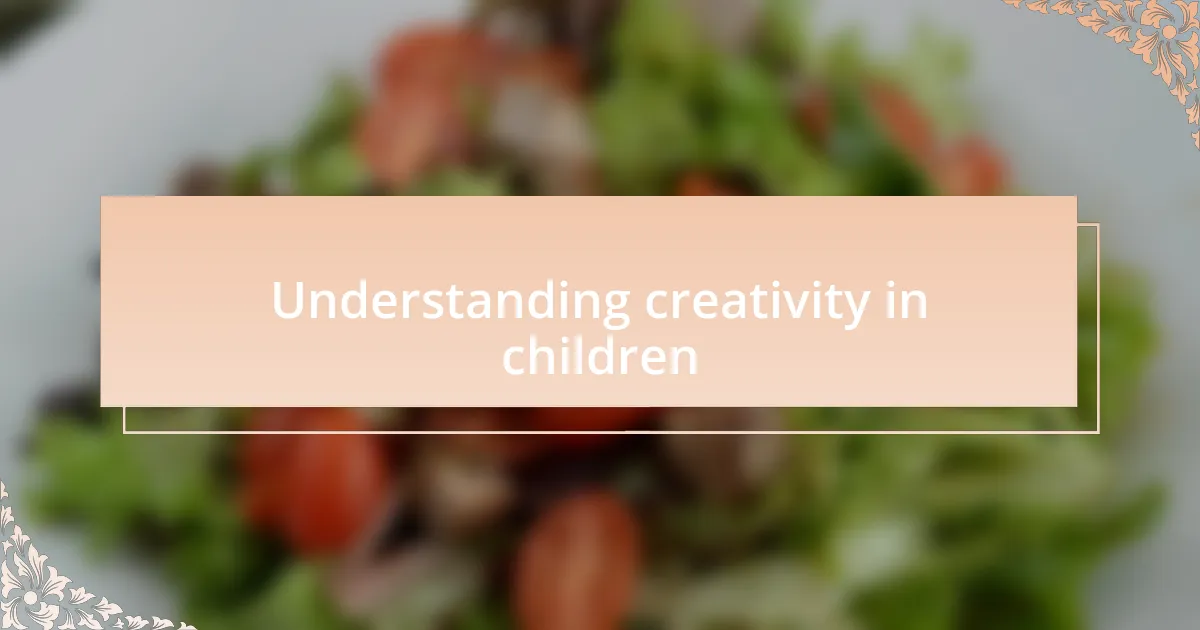
Understanding creativity in children
Creativity in children is a fascinating concept that often surprises adults when they witness the imaginative worlds their kids create. I remember watching my daughter transform a simple cardboard box into a spaceship, complete with sound effects and plot twists. It left me wondering: how do their minds weave such intricate stories from the everyday?
As I delve deeper into understanding creativity, I realize that it thrives on exploration and freedom. For instance, when my son was trying to draw a dinosaur, he didn’t just stick to traditional colors. Instead, he chose bright pink and glitter, redefining what a dinosaur could look like. This makes me reflect: shouldn’t we encourage our children to break the mold and see the extraordinary in the ordinary?
The beauty of children’s creativity lies in its unfiltered expression. Often, they are driven by pure curiosity rather than any expectation of perfection. I once took my children to a pottery class, and instead of carefully crafting symmetrical bowls, they eagerly slapped clay together, creating unique and whimsical shapes. It struck me—don’t we all yearn to have that freedom to create without limitations?
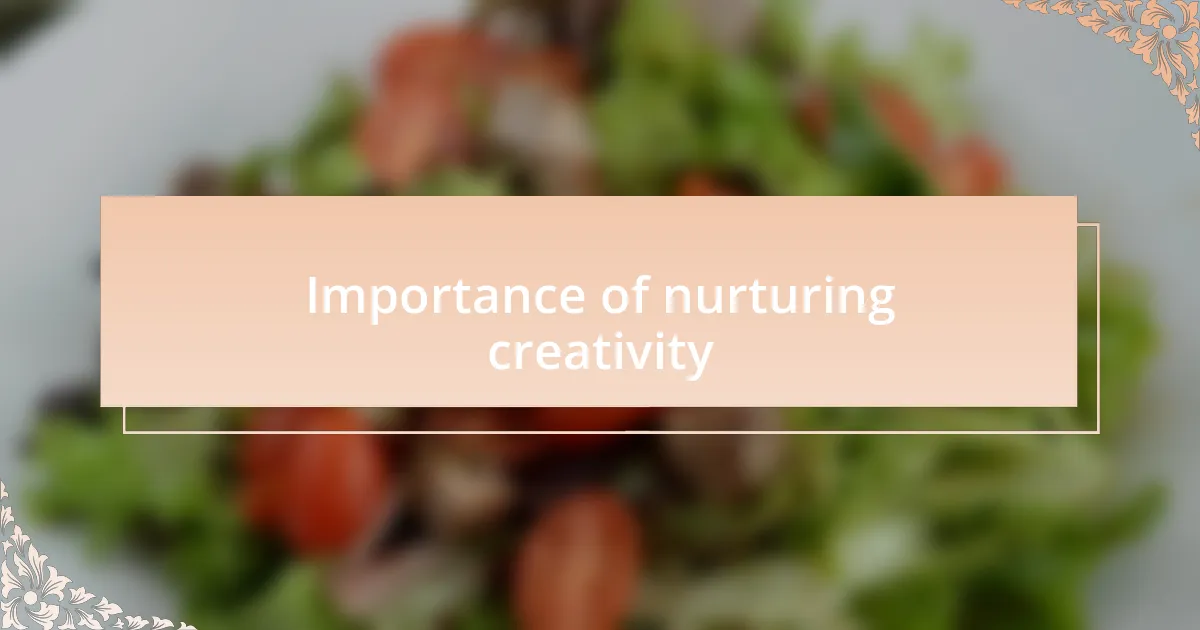
Importance of nurturing creativity
Nurturing creativity in children is essential for their overall development. When I see my kids dive into art projects after a family brunch, often covered in paint, I realize they’re not just having fun; they’re building problem-solving skills and self-confidence. How often do we consider that a simple moment of creativity can lead to life-long skills and inspirations?
Creativity fosters resilience by encouraging children to experiment and learn from failure. I vividly remember my daughter attempting to bake a cake, and instead of being discouraged by a collapsed version, she laughed and exclaimed, “It’s a pancake cake!” This playful mindset helps them embrace challenges later in life. Isn’t it incredible how a playful approach can shape their attitude toward setbacks?
Moreover, nurturing creativity enhances emotional intelligence. I noticed this during group playdates when kids invent games together, negotiating rules and roles seamlessly. In those moments, they not only express themselves but also learn to empathize and collaborate. Doesn’t it seem vital that we provide our children with opportunities to cultivate these emotional connections?
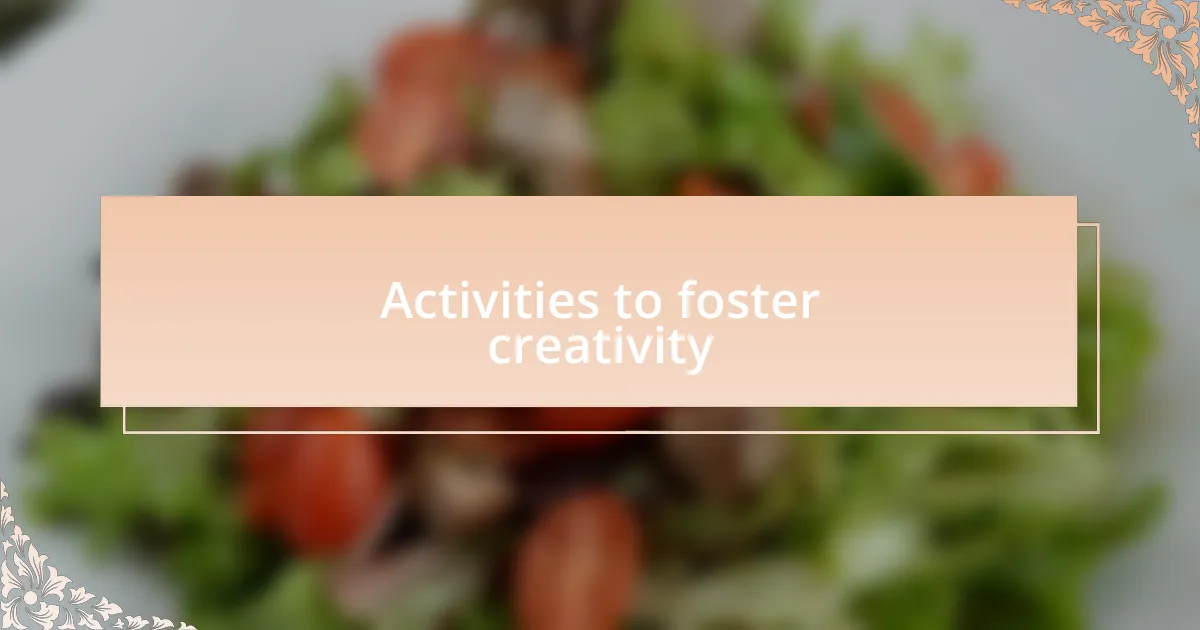
Activities to foster creativity
Engaging in hands-on activities can spark creativity in remarkable ways. I love setting up a mini kitchen at home where my kids can whip up their own unique recipes. One afternoon, my son decided to experiment by mixing ingredients that included peanut butter and honey, resulting in a concoction he named “The Sweet Surprise.” Watching his eyes light up with pride as he showed off his new dish made me appreciate the joy of exploration.
Artistic expression is another powerful avenue for creativity. On rainy days, we dive into a world of colors with painting or crafting projects. I recall one time when my daughter transformed everyday cardboard boxes into a fantastical castle, complete with a drawbridge and turrets. Her ability to see potential where there seemed to be none was a beautiful reminder that creativity thrives when we encourage our children to think beyond the ordinary.
Outdoor adventures are also a great way to foster creativity. Taking my kids to the park and allowing them to create their own games makes for memorable experiences. One afternoon, they turned a simple game of tag into an elaborate story about explorers searching for treasure. It’s intriguing how their imaginations can elevate a basic activity into something extraordinary. Don’t you think that allowing children to lead in their play nurtures their creative instincts even more?
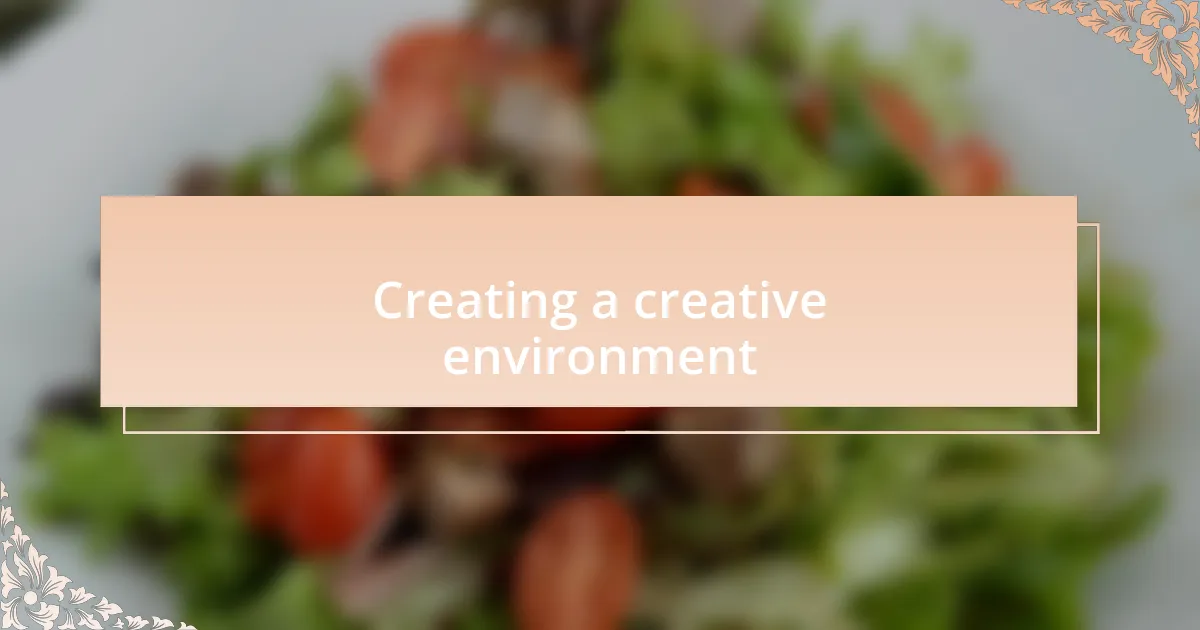
Creating a creative environment
Creating a space that encourages creativity starts with the environment itself. I’ve learned that bright colors and quirky decor can stimulate imagination. When we painted one room a vibrant shade of orange, it became my kids’ favorite spot to play and invent—every corner sparked new ideas. Isn’t it fascinating how a simple change in atmosphere can unleash a torrent of creativity?
Another key aspect is providing easy access to various materials. In my home, I keep a basket filled with recyclables like newspapers, bottle caps, and colored paper. One evening, my daughter surprised me by crafting a robot from those materials, and she named it “Mr. Bottlebot.” I marveled at how these seemingly ordinary items transformed into something so extraordinary through her eyes. How often do we overlook the potential in everyday items just waiting to be discovered?
Finally, I’ve found that encouraging open-ended play is essential. Instead of just giving my kids a toy, I often prompt them to create their own experiences. Recently, I witnessed my son turn a blanket into a spaceship, and he boldly declared that we were headed to Mars. This kind of imaginative play not only fosters creativity, but also strengthens problem-solving skills. Don’t you think our children teach us as much as we teach them when we step back and watch their creativity unfold?
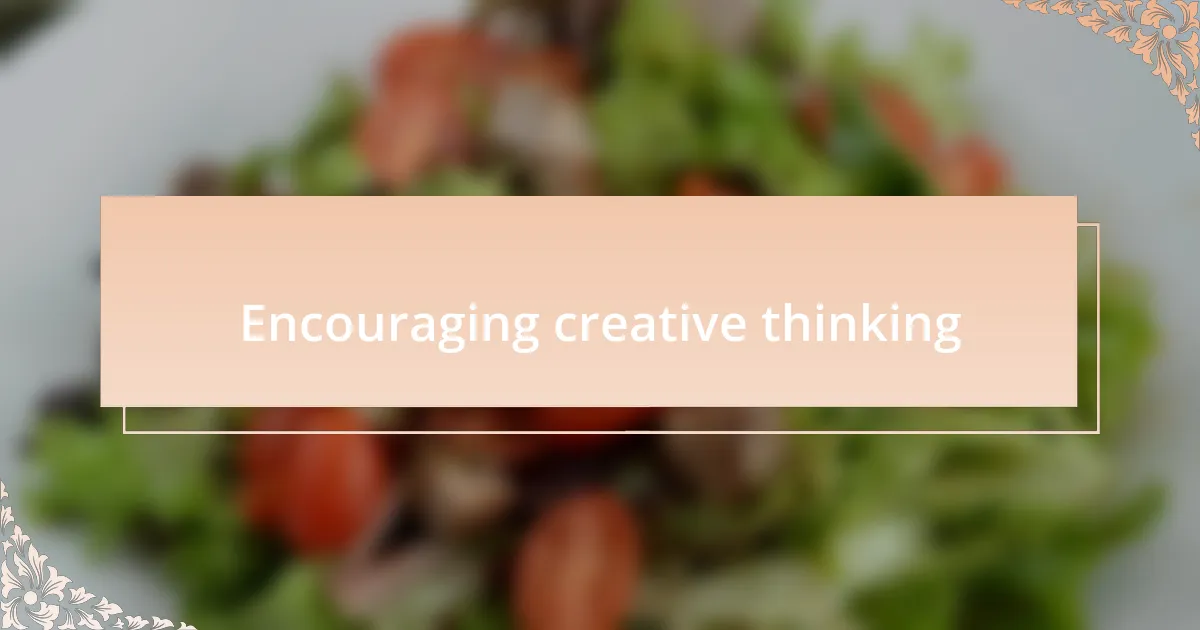
Encouraging creative thinking
Encouraging creative thinking often begins with dialogue and exploration. I make it a point to engage my kids in conversations that challenge their viewpoints. For instance, when we watch a movie, I ask them what they would have done differently if they were the director. Their answers are often wildly imaginative, and it’s amazing to see how these discussions spur further creative thoughts. Don’t you think that inviting kids to share their ideas empowers them to think outside the box?
I also emphasize the importance of experience. One rainy day, I took my children to a local art gallery. As we wandered through the vibrant displays, I encouraged them to express what they felt about each piece. Their interpretations were heartfelt and unique; my youngest even exclaimed, “That painting looks like a dance party!” By connecting emotions to art, they learned to view creativity as a personal journey, rather than just a skill. Isn’t it incredible how experiences can shape our children’s creative voices?
Another technique I find effective is incorporating games that require innovative thinking. We often play “What If” scenarios, where we explore absurd situations together. For example, I once asked, “What if trees could talk?” My children responded with animated ideas about giving trees outfits and personalities. These fun exercises not only entertain us but also reinforce their ability to think creatively. Wouldn’t it be wonderful if we all approached life with a playful curiosity?

Involving children in decision making
Involving children in decision-making can significantly boost their self-esteem and creativity. I often give my kids a say in planning our weekend activities. Once, I tossed out the idea of a picnic or a trip to the zoo. They eagerly debated their preferences, arguing for the zoo because they wanted to see the lions up close. It was rewarding to watch them articulate their reasoning and feel invested in the final choice. Isn’t it fascinating how letting them weigh in can enhance their sense of agency?
I also include my children in smaller daily decisions. For example, when we’re preparing a meal, I create an interactive experience by asking them what ingredients they think would make the dish better. Recently, as we made tacos, my oldest suggested adding mango salsa. Their playful engagement with food not only results in a delicious meal but allows them to express their creativity through flavors. Wouldn’t you agree that involving them in these choices makes cooking a fun adventure rather than a chore?
Finally, I’ve noticed that allowing my kids to contribute to family decisions strengthens our bond. During a recent family meeting about our summer vacation, I asked for their input on destinations. My youngest lobbied passionately for a beach trip, sharing visions of building sandcastles and collecting seashells. Hearing their excitement and validating their input allowed them to feel heard and valued. Doesn’t it warm your heart to see children thrive when they feel their opinions matter?
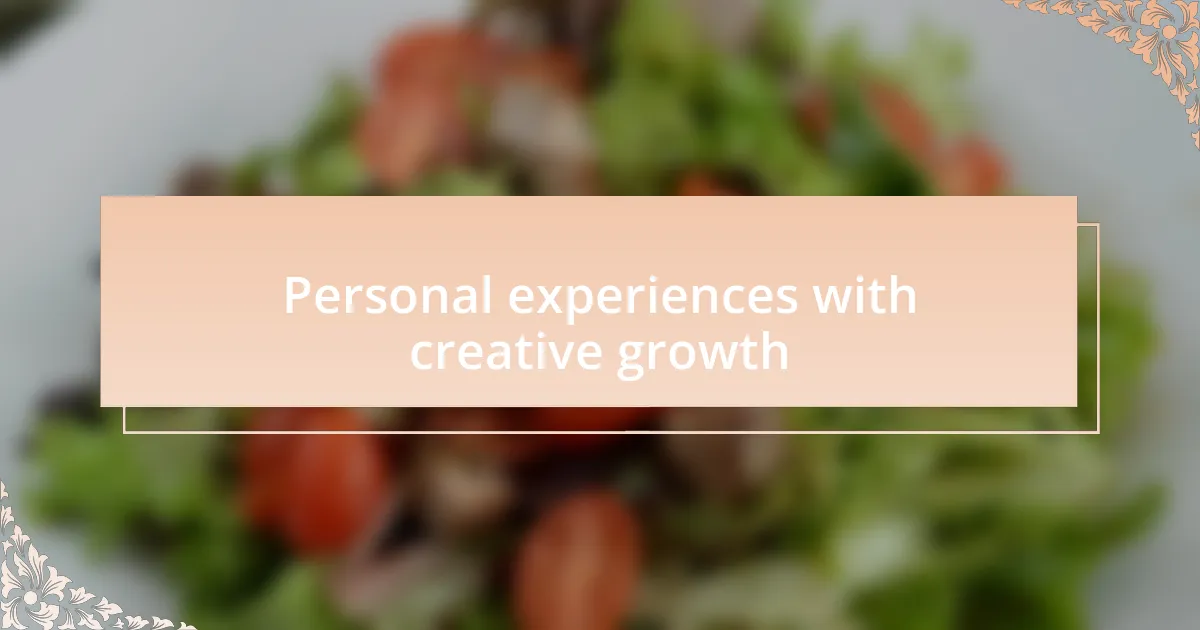
Personal experiences with creative growth
I’ve found that creative growth often blossoms when I share my own creative processes with my children. For instance, during a recent art session, I decided to try painting alongside them. I painted a simple landscape while they explored their imaginations with colors and shapes. What surprised me was how my willingness to be vulnerable—showing that I didn’t need to create something “perfect”—inspired them to take more risks in their artwork. Have you ever noticed how our own actions can encourage children to embrace creativity?
Another memorable experience occurred during a family game night. We decided to create our own board game, where each of us contributed ideas and components. It was a chaotic but joyful process; my youngest drew quirky game pieces while my oldest crafted the rules. Watching them collaborate and negotiate their ideas not only fueled their creativity but also taught them the value of teamwork. Isn’t it amazing how collaborative efforts can lead to unique forms of expression?
Celebrating small wins has also played a vital role in fostering creativity. After my kids completed a challenging project for school, I organized a mini exhibition at home, displaying their work proudly on the walls. The sheer joy on their faces as they showcased their creations left a lasting impression on me. I believe that acknowledgment of their efforts instills confidence in their abilities. How powerful it is to show children that their creative expressions are worthy of celebration!